Enterprise business intelligence gives you the power to turn data into fast, actionable insights across your organization. You now see a major shift from traditional bi, where quarterly planning and slow committee decisions were common, to enterprise bi that supports continuous strategy and rapid response. The move to enterprise bi means you can integrate data from many sources, scale analytics, and get real-time results. In fact, 58.7% of companies now use advanced bi platforms and 52.3% have standardized data across departments. Solutions like FineBI lead the way, helping you make better decisions, improve efficiency, and stay ahead in your industry.
Enterprise BI Explained
What Is Enterprise Business Intelligence
You need to understand what enterprise business intelligence means before you can use it to improve your organization. Enterprise business intelligence includes tools and processes that help you collect, analyze, and visualize data. These systems work across large organizations and support your operational and growth strategies. You can use enterprise bi to ingest, prepare, and analyze data from many sources. This approach gives you the ability to create dashboards, generate reports, and explore data on your own. You do not have to depend on IT for every request. You can make decisions faster and respond to changes in your business environment with more confidence.
Enterprise bi platforms give you self-service capabilities. You can access data, build dashboards, and share insights with your team. This independence helps you move quickly and stay competitive. You can use enterprise bi to support real-time analytics, which means you get up-to-date information for your decisions. You can also use these systems to visualize trends and patterns, making it easier to spot opportunities and risks.
Note: Enterprise bi is not just about technology. It is about empowering you and your team to use data for better decisions and improved performance.
Key Components of Enterprise BI
Enterprise bi includes several important components. Each one plays a role in helping you turn data into actionable insights.
| Component | Description |
|---|---|
| Data Integration | You can combine data from many sources, breaking down silos and creating a unified view. |
| Scalability | Enterprise bi systems handle large volumes of data and support many users at once. |
| Real-Time Insights | You get immediate access to data, allowing you to make decisions quickly. |
| Governance | You can control access, ensure data quality, and meet compliance requirements. |
| Self-Service BI | You can explore data and create reports without technical skills. |
| AI Automation | You can automate reporting and dashboard creation for faster insights. |
| Embedded BI | You can integrate bi tools into your existing software for easier access. |
| Large Language Models | You can use natural language to interact with data and get answers. |
You need all these components to build a strong enterprise bi solution. Data integration lets you connect different systems and departments. Scalability ensures your bi platform grows with your business. Real-time insights help you react to changes as they happen. Governance keeps your data safe and accurate. Self-service bi gives you the freedom to analyze data on your own. AI automation and embedded bi make your workflows smoother. Large language models make it easier to ask questions and get answers from your data.
Tip: When you choose an enterprise bi solution, look for platforms that offer strong data integration, scalability, and real-time analytics. These features will help you get the most value from your data.
How FineBI Support Enterprise BI
You want a platform that supports all the key components of enterprise bi. FineBI give you powerful tools to manage data, generate insights, and scale your analytics across the enterprise.
| Feature | FineBI | Other Platforms |
|---|---|---|
| Data Handling | Can manage large volumes of customer data | Varies by platform |
| Data Security | Ensures data safety and privacy | Varies by platform |
| Insight Generation | Provides quick insights for decision-making | Varies by platform |
| Data Source Connectivity | Works with over 100 data sources | Varies by platform |
| Data Pipeline Creation | Drag and drop interface for easy setup | Varies by platform |
| Real-time Data Processing | Supports both offline and real-time data | Varies by platform |
| API Interface Creation | Quick setup for sharing data between systems | Varies by platform |
FineBI uses advanced technology to help you integrate data from many sources. You can connect to over 100 data sources, including databases, cloud platforms, and APIs. FineBI lets you create data pipelines with a drag-and-drop interface. You can process data in real-time or offline, depending on your needs. You can also set up API interfaces quickly, making it easy to share data between systems.
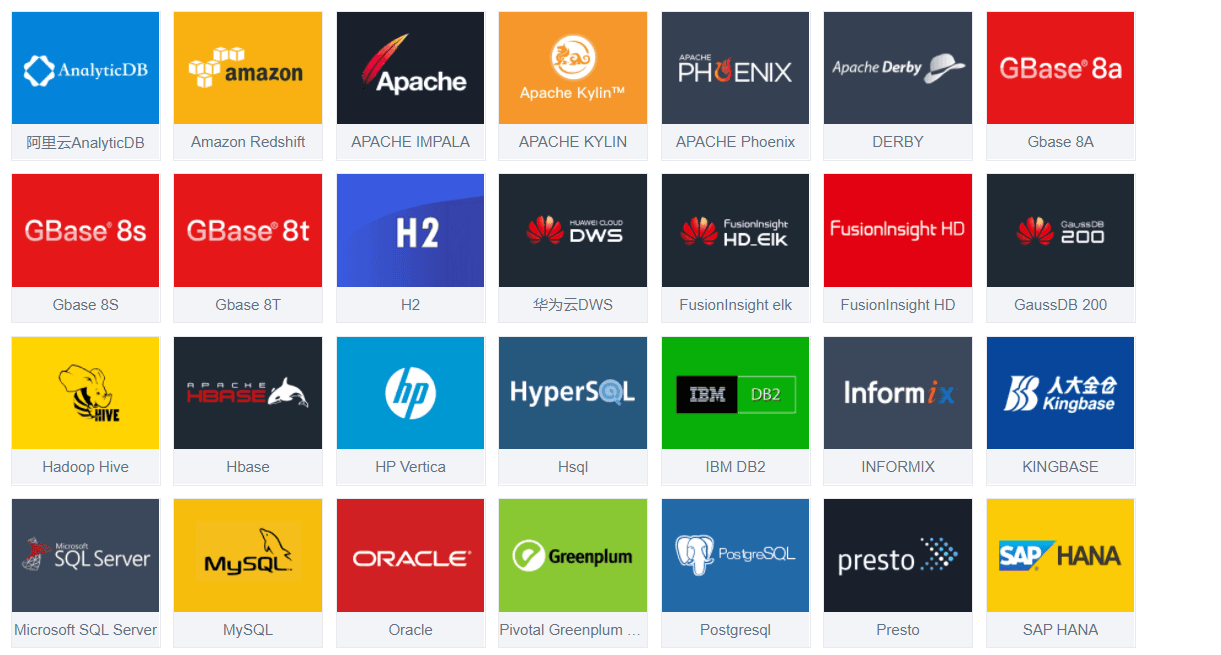
Scalability is another strength of FineBI. You can manage data sets with more than 100 million records. The Spider distributed engine helps you analyze massive data volumes efficiently. You can use offline computing for flexible analysis and integrate big data components like Spark and HDFS. The architecture supports continuous operation, so you can rely on your enterprise bi solution all year round.
You can use FineBI to get real-time insights, improve reporting, and make better decisions. These platforms give you the tools you need to succeed in a data-driven world.
You can trust FineBI to deliver high performance, strong security, and easy-to-use analytics. You can empower your team to explore data, create dashboards, and share insights across the enterprise. You can break down silos, improve collaboration, and drive growth with a modern enterprise bi solution.
Why Enterprise BI Matters
Business Impact and Competitive Advantage
You want your organization to grow and stay ahead of competitors. Enterprise bi helps you achieve this by turning data into actionable insights. You can use enterprise bi to analyze trends, model scenarios, and predict outcomes. This approach supports business growth and gives you a competitive edge.
- Nearly 80% of businesses now use bi and data analytics software.
- Industries such as inventory management, marketing, engineering, insurance, and IT services lead in bi adoption.
You can anticipate market trends and customer behaviors with predictive analytics. You can model different scenarios to prepare for future challenges. You can implement strategies that drive sustained success. For example, Telefonica used enterprise business intelligence to discover a mid-sized customer group that delivered higher ROI and retention than larger clients. This insight led to a strategic shift and a significant revenue increase within months.
You can see how other companies gained advantages with enterprise bi:
| Company | Challenge | Solution | Results |
|---|---|---|---|
| Lotte.com | Shopping cart abandonment | Customer experience analytics | Increased loyalty and $10 million in sales |
| Cementos Argos | Competitive advantage and better decisions | Business analytics center, data science teams | Standardized finance, higher profitability |
| Baylis & Harding | Visibility into data | BI tools for reports | Instant access to data, proactive decisions |
| Sabre Airline Solutions | Need for real-time data insights | Enterprise travel data warehouse | More revenue, increased client satisfaction |
| Spear Education | Inefficient customer service phone system | BI solution integration | Increased efficiency, saved 35 hours per week |
| Univision | Visibility for ad campaigns | Programmatic TV with BI | 80% growth in yield |
| New York Shipping Exchange | Manual data extraction | Centralized data system | Tripled shipping volume between Asia and U.S. |
| Stitch Fix | Reducing returns, improving retention | BI for customer preferences | Grew customer base to 3.4 million, $1.7 billion revenue |
You can use enterprise bi to standardize processes, improve profitability, and make proactive decisions. You can gain instant access to business data and respond quickly to market changes.
Real-Time Insights for Better Decisions
You need real-time insights to make better decisions. Enterprise bi gives you immediate access to data, so you can act fast and stay informed. You can use real-time reporting to monitor key metrics and adjust your strategy as needed.
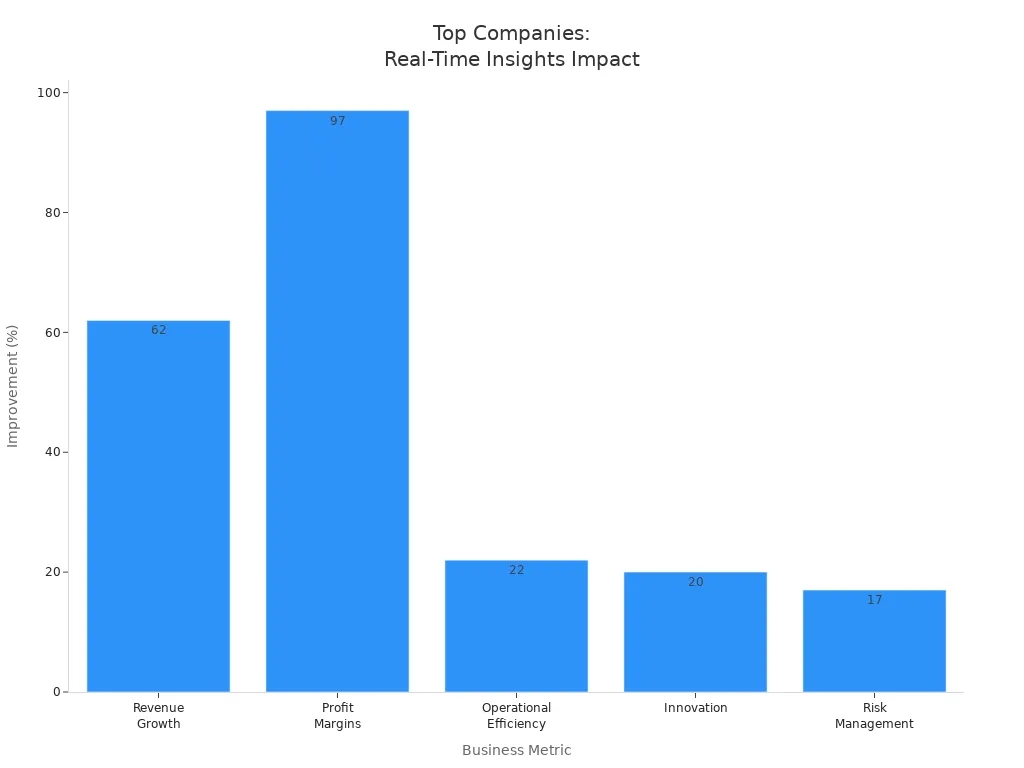
You can improve operational effectiveness by 30-50% with enhanced visibility. Teams can adjust quickly when they have access to real-time KPI dashboards. You can use enterprise bi to track performance, spot issues, and make data-driven decisions. You can reduce risks and boost innovation by acting on up-to-date information.
FanRuan’s Value in Enterprise BI
You want an enterprise bi solution that delivers real value. FanRuan offers comprehensive services for all your analytics needs. You can use FineBI and FineReport for self-service analytics and structured reporting. You can integrate data from many sources and process large datasets efficiently. This flexibility supports your enterprise as it grows.
| Value Proposition | Description |
|---|---|
| Comprehensive Services | FineBI and FineReport provide tools for self-service analytics and structured reporting. |
| Scalability and Flexibility | FineBI integrates with various data sources and handles large datasets for growing enterprises. |
| Quality Customer Support | FineBI offers training and a user-friendly interface for better usability and support. |
| Alignment with Business Goals | FineBI streamlines decision-making with real-time insights and customizable dashboards. |
| Cost-Effectiveness | FineBI and FineReport deliver advanced features at competitive prices, boosting ROI and productivity. |
You can align your bi strategy with business objectives using customizable dashboards and real-time insights. You can rely on quality customer support and training to maximize your investment. You can achieve cost-effective analytics and reporting, driving productivity and business growth.
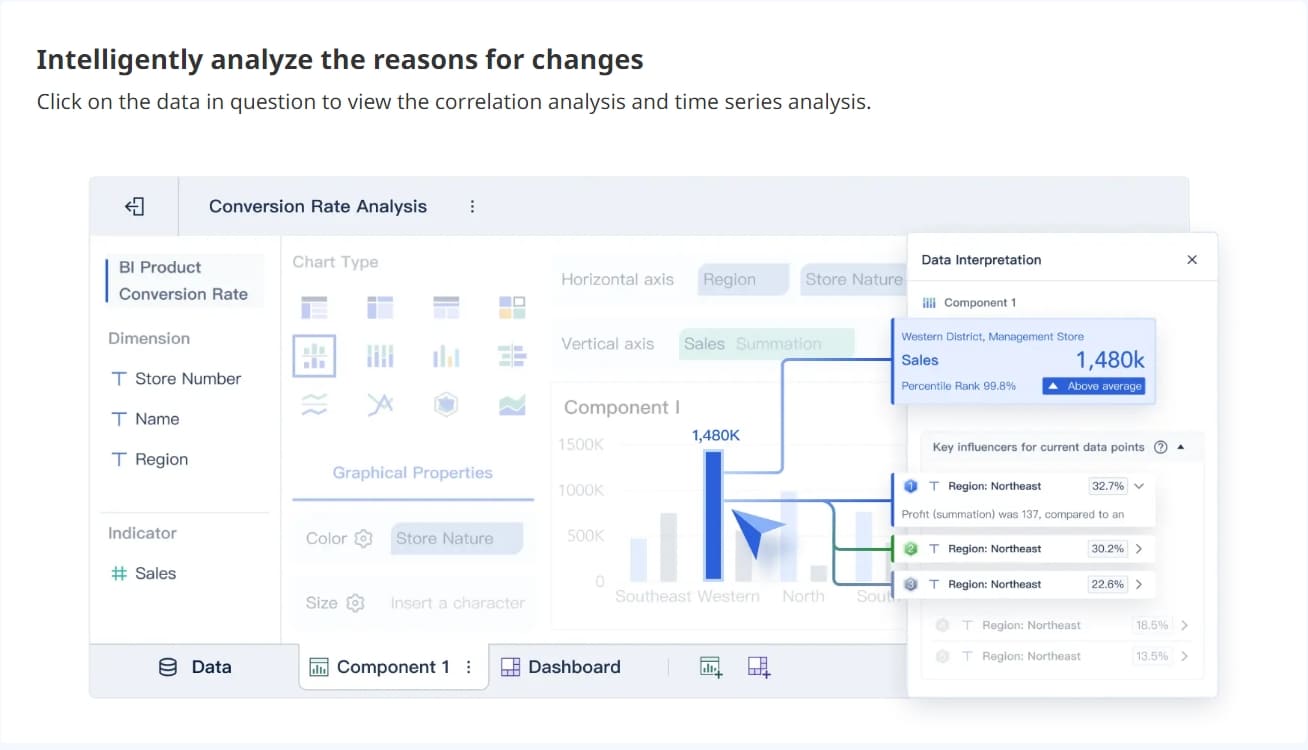
Tip: When you choose FanRuan, you get a scalable, flexible, and user-friendly enterprise bi solution. You can empower your team to make data-driven decisions and unlock new opportunities for your enterprise.
Benefits of Enterprise BI Solutions

Scalability and Data Integration
You need enterprise bi solutions that scale with your business. These platforms handle large and complex data sets, supporting thousands of users across departments. Enterprise bi manages data from many sources, breaking down silos and creating a unified view. You can see the difference in how enterprise bi compares to traditional bi tools:
| Feature | Enterprise BI | Traditional BI |
|---|---|---|
| Data Handling | Manages larger, complex datasets | Handles smaller datasets from specific departments |
| Scalability | Scales to meet growing data needs | May struggle with increasing data volumes |
| User Base | Holistic solution across the organization | Caters to specific departments or teams |
| Complexity and Scope | Includes advanced features like predictive analytics and AI | Lacks advanced features available in Enterprise BI |
FineBI supports over 100 data sources and offers real-time data processing. You can connect databases, cloud platforms, and APIs, making data integration simple and efficient. This flexibility helps you keep up with business growth and changing requirements.
Enhanced Collaboration and Governance
Enterprise bi improves collaboration and governance. You can work with your team on the same analysis subject at the same time. FineBI lets multiple users edit, share, and manage folders together. Administrators control permissions, ensuring secure access to data and reporting.
A strong data governance framework defines rules, roles, and processes. You keep data trustworthy and secure, meeting compliance requirements and supporting data-driven decisions.
You need to identify key compliance mandates and understand regulations to avoid costly penalties. Enterprise bi platforms embed access control, data lineage tracking, and compliance standards like GDPR into their architecture. This approach keeps your data safe and your reporting accurate.
Real-Time Insights with FineBI
You want real-time insights to make better decisions. FineBI delivers immediate updates through real-time reporting and analytics. The platform uses an in-memory computing engine for fast response times, even with complex queries. You can access insights on mobile devices, supporting timely decisions wherever you are.
| Feature | Description |
|---|---|
| Real-time data processing | FineBI processes data in real-time, allowing for immediate insights and updates. |
| Integrated ETL tools | The platform includes tools for data preparation, enhancing the efficiency of data handling. |
| Mobile app support | Users can access insights on mobile devices, ensuring timely decision-making in enterprises. |
| Scalability | FineBI can scale with business needs, accommodating growth from small to large data requirements. |
| Fast response times | The in-memory computing engine provides quick responses even for complex queries. |
| Enterprise-grade security | Features like role-based access control and audit logging ensure data security in enterprise use. |
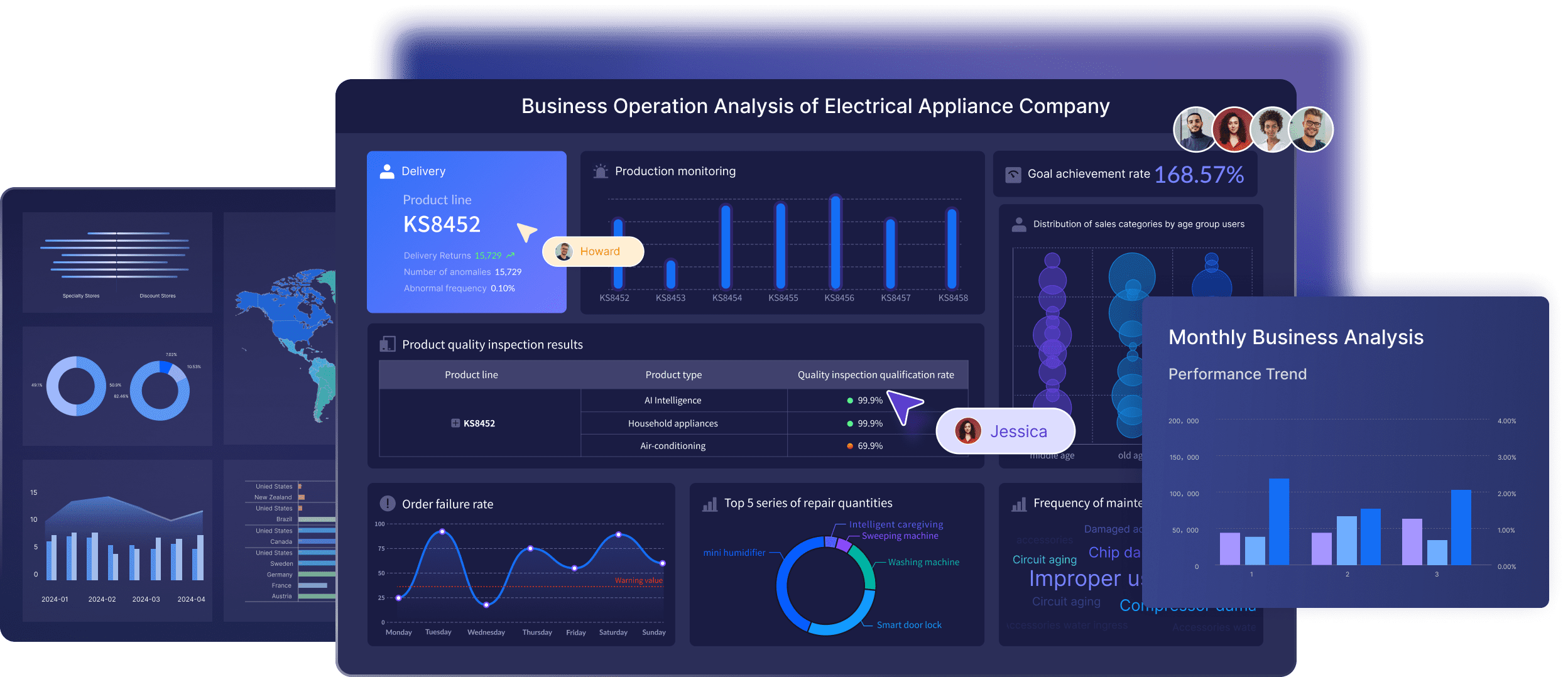
You can automate data processes, freeing employees from repetitive tasks and optimizing workflows. Enterprise bi helps you analyze customer data, uncover trends, and improve marketing strategies. You gain a competitive advantage through smarter, data-driven strategies. You also support regulatory compliance and risk management, preventing costly issues.
Tip: Organizations measure ROI by tracking process automation rates, cost per transaction, and fraud detection accuracy. Enterprise bi solutions often deliver a payback period of less than a year.
You empower your team to make data-driven decisions, improve productivity, and drive business growth with enterprise bi.
Enterprise BI vs. Traditional BI

Scope and Scale Differences
You need to understand how enterprise bi differs from traditional bi. Traditional bi tools often focus on specific departments and handle smaller datasets. You might use them for basic reporting or to look at historical data. Enterprise bi platforms work across your entire organization. You can manage large volumes of data from many sources. Enterprise bi supports thousands of users and scales as your business grows. You get a unified view of your enterprise, breaking down silos and improving collaboration. Real-time data processing lets you see changes as they happen, so you can make faster decisions.
Strategic Value of Enterprise BI
Enterprise business intelligence gives you more than just reports. You use it to drive strategy and shape future outcomes. Traditional bi helps you understand past performance, but enterprise bi helps you predict trends and act before problems arise. You move from reactive decisions to proactive planning. The table below shows how the strategic value of enterprise bi compares to traditional bi:
| Aspect | Traditional BI | Enterprise BI |
|---|---|---|
| Focus | Historical data and descriptive analytics | Predictive and prescriptive capabilities |
| Purpose | Understanding past performance | Driving actionable strategies |
| Decision-making | Reactive, based on historical insights | Proactive, shaping future outcomes |
| Long-term outcomes | Slower operational responses, missed opportunities | Enhanced competitiveness, growth opportunities |
You gain a competitive edge and open new growth opportunities with enterprise bi. You use advanced analytics and real-time insights to guide your business forward.
FineBI’s Differentiation
FineBI stands out among enterprise bi solutions. You get a platform that supports self-service analytics, real-time reporting, and seamless data integration. You can unify information from every part of your enterprise. You build dashboards with drag-and-drop simplicity, making insights accessible to everyone. FineBI’s in-memory engine delivers fast results, even with complex queries. You control access with enterprise-grade security, ensuring your data stays safe.
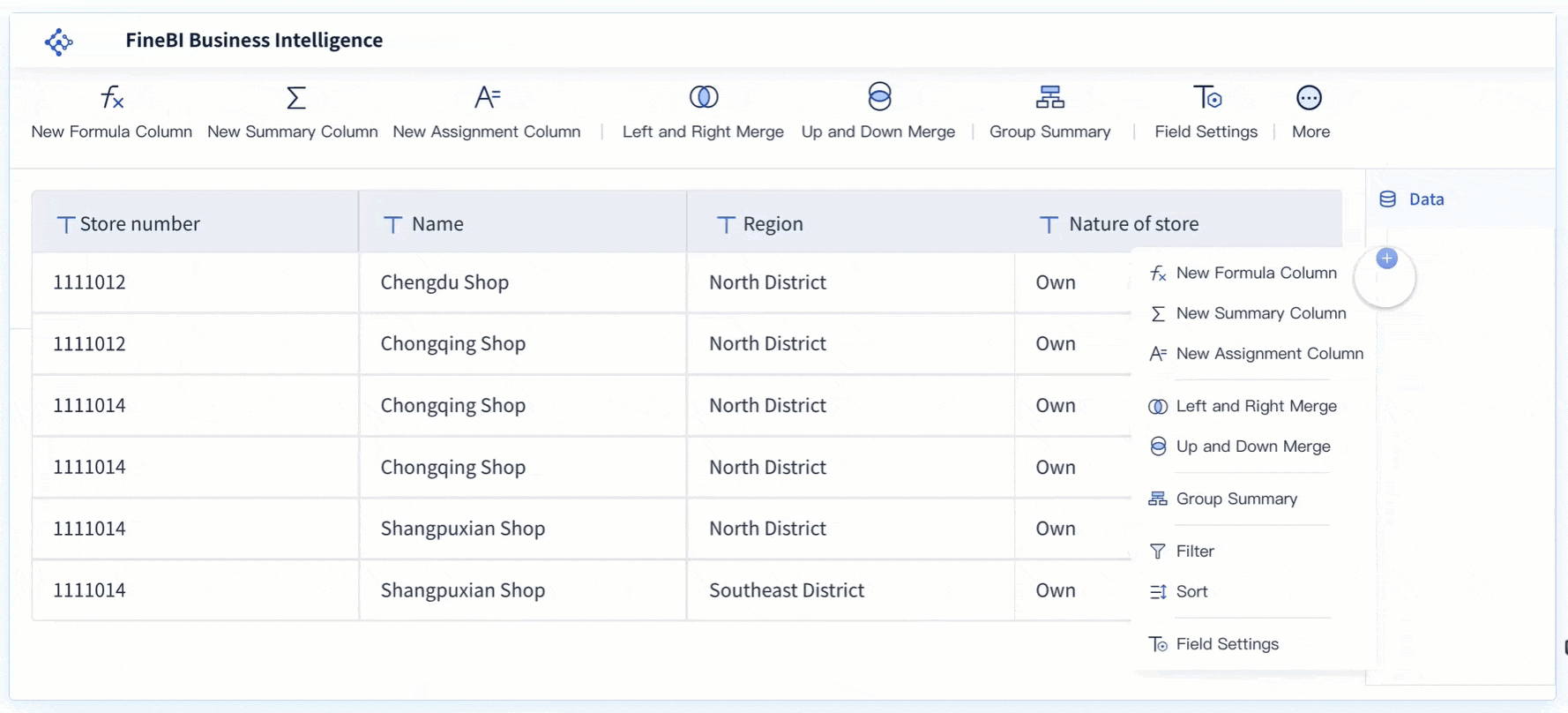
Many people think bi is just a reporting tool or only for large organizations. Experts say bi is a continuous process that adapts to your needs. You use bi to track projects, make decisions, and improve performance. FineBI makes enterprise bi affordable and accessible, so teams of any size can benefit. You empower every member of your organization to use data for smarter decisions.
Tip: Business intelligence is not a one-time project. You need to keep evolving your enterprise bi strategy as your business grows and changes.
Getting Started with Enterprise BI
Who Needs Enterprise BI
You might wonder if your organization is ready for enterprise bi. Many industries benefit from adopting these solutions. You can see how different sectors use bi to improve performance and make better decisions.
| Industry | Benefits |
|---|---|
| Retail | Analyze shopping habits, maximize inventory, personalize promotions. |
| Healthcare | Monitor patient outcomes, predict disease outbreaks, optimize hospital operations. |
| Finance | Risk analysis, fraud detection, financial forecasting. |
| Manufacturing | Predict equipment failures, minimize downtime, improve supply chain logistics. |
| Hospitality | Analyze guest comments, forecast occupancy levels, personalize offers and services. |
| Education | Monitor student performance, optimize resource utilization, enhance curriculum planning. |
You see the impact across business units. Operations and marketing teams use bi to drive strategic initiatives. Low-code platforms empower users to design solutions without heavy IT involvement. Cross-department collaboration grows stronger as teams work together on analytics projects.
Tip: You may face resistance from employees who prefer traditional methods. Training programs and clear communication help your team embrace new tools and workflows.
Steps to Implement Enterprise BI with FanRuan
You want to start your enterprise bi journey with confidence. FanRuan provides a clear path for successful implementation. Follow these steps to build a strong foundation for bi, reporting, and real-time insights.
| Step | Description |
|---|---|
| Strategic Planning | Set clear objectives and align bi strategy with your business goals. |
| Choosing the Right Tools | Evaluate and select bi software like FineBI for features, compatibility, and customization. |
| Continuous Monitoring | Establish KPIs and feedback loops to improve your bi system and maintain effectiveness. |
You may encounter challenges such as data integration complexity, poor data quality, and scalability issues. FanRuan helps you overcome these obstacles by offering robust data management, secure governance, and scalable architecture. You ensure your enterprise stays agile and ready for growth.
Note: You should involve key stakeholders early, define roles, and encourage user adoption. This approach leads to better decisions and more valuable insights from your analytics platform.
Enterprise business intelligence helps you make smarter decisions and improve your business. You gain real-time, accurate information, boost efficiency, and stay ahead of competitors.
| Benefits | Description |
|---|---|
| Data Integration | Combines data from all departments for better insights. |
| Scalability | Handles more data as your company grows. |
| Real-Time Insights | Gives you up-to-date dashboards for quick decisions. |
FanRuan and FineBI offer self-service analytics, interactive dashboards, and mobile access. Try these tools to unlock the full value of your data.
FAQ

The Author
Lewis
Senior Data Analyst at FanRuan
Related Articles

Business Intelligence Engineer Amazon Salary Revealed
The average business intelligence engineer amazon salary in 2025 is $101,752, with total compensation reaching up to $224,000 based on level.
Lewis
Sep 09, 2025

Use Excel Business Intelligence For Smarter Data Analysis
Excel business intelligence tools help you analyze data, build dashboards, and automate reports for smarter, faster business decisions.
Lewis
Sep 09, 2025

How to Land a Business Intelligence Internship Easily
Apply for a business intelligence internship in 2025 with top skills, BI tools, and resume tips to stand out and secure your ideal position.
Lewis
Sep 09, 2025




